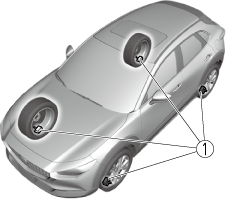Tyre Pressure Monitoring System (TPMS)
Tyre Pressure Monitoring System (TPMS) (Some Models)
Tyre Pressure Monitoring System (TPMS)
The TPMS monitors the air pressure of each tyre and if it decreases below the specified value, the system notifies the driver by turning on the TPMS warning light in the instrument cluster and indicating a message on the multi-information display.
For the TPMS, the air pressure data sent from the tyre pressure sensors installed on each wheel via radio signal is received by the receiver unit in the vehicle to monitor the tyre pressures.

-
Tyre pressure sensors
In addition, the current tyre pressures can be checked using the centre display.
Refer to the Vehicle Status Monitor section in the Mazda Connect Owner's Manual.
-
When the ambient temperature is low, the tyre temperatures also decrease. If the tyre temperatures decrease, the air pressure in the tyres will also decrease which could turn on the TPMS warning light.
-
Before driving, visually inspect the tyres for abnormalities. Additionally, inspect the tyre pressures monthly. A digital type air pressure gauge is recommended for inspecting the tyre pressures.
The TPMS is not a substitute for your own periodic inspection of the tyres. Always inspect the tyres yourself periodically.
-
Each tyre, including the spare (if provided), should be checked monthly when cold and inflated to the inflation pressure recommended by the vehicle manufacturer on the vehicle placard or tyre inflation pressure label. (If your vehicle has tyres of a different size than the size indicated on the vehicle placard or tyre inflation pressure label, you should determine the proper tyre inflation pressure for those tyres.)
As an added safety feature, your vehicle has been equipped with a tyre pressure monitoring system (TPMS) that illuminates a low tyre pressure telltale when one or more of your tyres is significantly under-inflated. Accordingly, when the low tyre pressure telltale illuminates, you should stop and check your tyres as soon as possible, and inflate them to the proper pressure. Driving on a significantly under-inflated tyre causes the tyre to overheat and can lead to tyre failure. Under-inflation also reduces fuel efficiency and tyre tread life, and may affect the vehicle's handling and stopping ability.
Please note that the TPMS is not a substitute for proper tyre maintenance, and it is the driver's responsibility to maintain correct tyre pressure, even if under-inflation has not reached the level to trigger illumination of the TPMS low tyre pressure telltale.
Your vehicle has also been equipped with a TPMS malfunction indicator to indicate when the system is not operating properly.
The TPMS malfunction indicator is combined with the low tyre pressure telltale. When the system detects a malfunction, the telltale will flash for approximately one minute and then remain continuously illuminated. This sequence will continue upon subsequent vehicle start-ups as long as the malfunction exists. When the malfunction indicator is illuminated, the system may not be able to detect or signal low tyre pressure as intended. TPMS malfunctions may occur for a variety of reasons, including the installation of replacement or alternate tyres or wheels on the vehicle that prevent the TPMS from functioning properly. Always check the TPMS malfunction telltale after replacing one or more tyres or wheels on your vehicle to ensure that the replacement or alternate tyres and wheels allow the TPMS to continue to function properly.
-
To avoid false readings, the system samples for a little while before indicating a problem. As a result it will not instantaneously register a rapid tyre deflation or blow out.
If there is a problem with the Tyre Pressure Monitoring System (TPMS)
If the TPMS warning light flashes, there may be a problem with the system. Consult an expert repairer (we recommend an Authorised Mazda Repairer) to have the system inspected.
Refer to Tyre Pressure Monitoring System (TPMS) Warning Indication/Warning Light (Flashing) (Search).
In the following cases, the system cannot recognise the tyre pressures correctly and the TPMS warning light may flash.
-
There is equipment or a device nearby emitting radio signals the same as a tyre pressure sensor.
-
A metallic object such as a non-genuine electronic device is installed near the centre of the instrument panel (obstructs the radio signals from the tyre pressure sensors to the receiver).
-
A device such as one of the following is used in the cabin.
-
Electronic devices such as a computer.
-
Converter devices such as a DC-AC converter.
-
-
There is a large accumulation of snow or ice around the vehicle tyres.
-
The battery in a tyre pressure sensor is dead.
-
A wheel not equipped with a tyre pressure sensor is used.
-
Tyres employing steel in the sidewall of the tyre are installed.
-
Tyre chains are used.
When a tyre pressure decreases
If the TPMS warning light turns on, a tyre pressure may be low. Inspect the tyre pressures and adjust them to the correct inflation pressure.
Refer to Tyre Pressure Monitoring System (TPMS) Warning Indication/Warning Light (Turns on) (Search).






























































